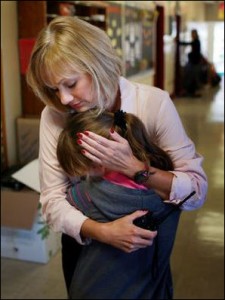by James A. Bacon
Highland View Elementary School educates children from one of the poorest districts in Bristol, a city where the poverty rate is nearly twice the state average. Poor families, mostly white, grapple with the same kinds of issues commonly associated with inner-city black families in Virginia’s urban crescent: broken families, high unemployment, alcohol and drug addiction, disorganized lives, abuse, neglect, hunger and a lack of interest in academic achievement.
Yet somehow, Highland View accomplished something that 556 other schools with large at-risk student bodies did not. Reports Jim Nolan with the Richmond Times-Dispatch: “For the first time since 2011, it earned full accreditation from the state Department of Education. More than 70 percent of its students passed the Standards of Learning exams in math, science and history, and 75 percent cleared the benchmark in English.”
How did Highland View achieve full accreditation despite a 11% cut in per-pupil spending over 10 years?
Much of the credit goes to Principal Pam Smith, who recognizes that it takes more than textbooks and teaching to help poor children. “The school is their counselor, their doctor, their nutritionist, their mother,”she said. “We’re their family.” As Nolan tells the story, Smith knows the story behind every child, whether he or she is homeless and couch surfing (sleeping on couches in different homes), is hearing disabled, is being raised by a grandparent or has a father with Post Traumatic Stress Disorder.
Credit goes, too, to the Bristol community, which has rallied behind the school. Home Depot has given Kindergarten cubbies. O’Reilly Auto Parts chipped in $800 to fund snacks for the after-school program. The local Kiwanis Club provides free vision screening and has contributed 100 pairs of shoes. Churches donate “snack packs” for kids to take home on weekends. Families contribute second-hand clothing so the school can maintain an inventory for when children appear at school in hopeless dirty, ragged or inappropriate clothing. A not-for-profit group, Communities in Schools, works closely with the Highland View to help families obtain counseling, housing, clothing, food, school supplies and transportation from local government agencies and not-for-profits.
By providing essential needs that parents have failed to provide their children, Highland View gives its pupils a fighting chance to earn an education and become productive citizens rather than fall into the quicksand of inter-generational poverty.
Bacon’s bottom line: Highland View is a success story. It is an example to be emulated. However, the nature of poverty in America today is such that, despite the existence of food stamps, temporary assistance for needy families, the earned income tax credit, Medicaid, nutritional programs for women with infants and young children, school lunch programs, housing assistance, child welfare services, and substance abuse & mental health programs, not to mention a host of private, not-for-profit enterprises filling gaps in the social safety net, the number of dysfunctional families appears to be increasing.
The problem is not simply that families are poor and have fallen on hard times, a predicament which some manage to work their way out of. The problem is that an increasing number of families are hopelessly irresponsible and disorganized. They lack the skills to function in contemporary society. They perform so badly as parents that society increasingly has to step in and fill their role. If children suffer from dysfunctional families in elementary school, does anything change when the children move onto middle school? How often are the gains achieved at Highland View lost in later years?
As a society, we are morally compelled to try to rescue these poor children. But I have to ask, do our good intentions aggravate the problems they are meant to solve? Do we make it easier for lousy parents to be even lousier parents? There has always been poverty in America. But I fear we are unintentionally creating a generation of poor people more lacking in basic life skills than at any time in American history.



